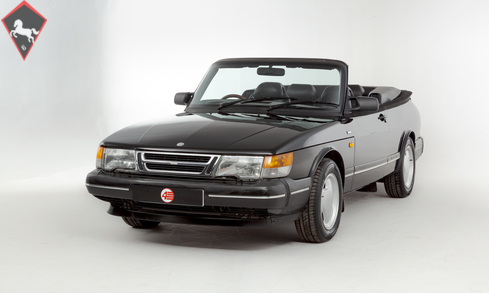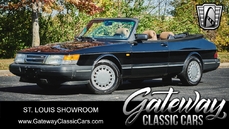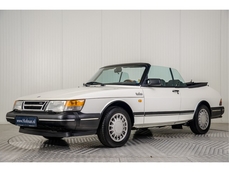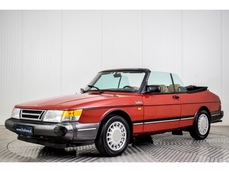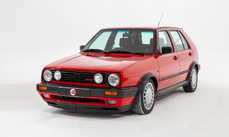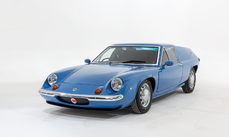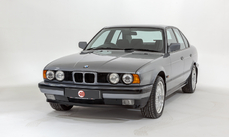Saab 900 16v Cabriolet 1992
Allmän beskrivning :
Model History
The Saab 900 was produced from 1978 until 1998. The first generation (produced until 1993) is known as the "classic" while the 1994-1998 models are known as the "new generation”. The classic 900 was based on the 99 chassis while the later models used that of the Opel Vectra. General Motors’ influence from 1994 marked the end of Saab's technology-driven design philosophy and the beginning of the dilution of the Saab brand.
The 900 sported a deeply curved front windscreen, providing the best driver visibility, calling attention to the marque's aircraft legacy. Also underscoring their aircraft lineage, the 900's dashboard was curved to enable easy reach of all controls and featured gauges lit up from the front. Saab engineers placed all controls and gauges in the dashboard according to their frequency of use and/or importance, so that the driver need only divert their gaze from the road for the shortest possible time and by the smallest angle. This is why, for example, the oft-used radio is placed so high in the dashboard.
In keeping with the paradigm of its predecessor, the 99 model, the 900 employed a door design unique in automotive manufacturing, with an undercutting sweep to meet the undercarriage, forming a tight, solid unit when the door was closed. This feature also eliminated the stoop in the cabin at the footing of the door, as seen in automobiles of other manufacturers, thereby preventing water and debris from collecting and possibly entering the cabin or initiating corrosion, as well as enabling passengers to enter and exit the cabin without need to step over several inches of ledge.
The 900 underwent minor cosmetic design changes for 1987, including restyled front-end and bumpers that went from a vertical to a more sloped design; sheet metal body parts were unchanged. Being a small car factory, for economic reasons, Saab kept the basic undercarriage more or less unchanged throughout the 900's production run.
Production of the first 900 cabriolet started during the spring of 1986. The convertibles predominantly featured a turbocharged 16v engine but were also offered with a fuel-injected naturally aspirated engine, as featured here.
Equipment
Electric-folding roof, Tonneau cover with storage bag, Electric windows, Kenwood CD player with Bluetooth, Electrically adjustable door mirrors, Spare wheel and jack, Nardi wooden steering wheel, Lockable glovebox, Cigarette lighter, Spare key.
Exterior
The black paintwork is very well preserved throughout with only a few discreet areas showing age-related marks. Towards the front of the car the body is in good order with no major blemishes to report. The oversized bumpers and black trim are in fine fettle with no fading and just a few scuffs to be found on close inspection. The black electrically-operated soft-top works exactly as it should and remains in excellent condition having been replaced in 2015 at a cost of over £900. This example also comes with the rare tonneau cover and storage bag, both of which are in perfect condition.
Interior
The classic Saab interior is a very pleasing place to sit. The first thing you’ll notice is the beautiful 3-spoke wood rim Nardi steering wheel, a great looking option that feels lovely in-hand – the original steering wheel is still present. A tasteful Kenwood CD player with Bluetooth is in place for modern convenience. The seats are trimmed in black leather, a great colour combo with the black roof and bodywork. All the seats are in fine order with no major wear to be found on any of the bolsters or bases. Lifting the rear hatch you’ll find a clean load compartment with the alloy spare wheel and jack, which is located neatly beneath the removable floor panels.
ENGINE & TRANSMISSION
The Saab is equipped with a two-litre naturally aspirated 16v engine producing 123hp. On first turn of the key the car fires quickly into life and idles up to temperature smoothly. Despite its modest performance figures the 900i provides a smooth yet engaging drive with plenty of Swedish charm.
With just 119k miles to its name – reasonably low mileage in Saab terms – the engine pulls well and the auto ‘box shifts seamlessly through the gears. The car has recently been inspected on arrival at 4 Star, with a clean bill of health and MOT valid until May 2020.
WHEELS, TYRES & BRAKES
The retro 15-inch Saab Directional alloy wheels look fantastic and remain in good order all round with the exception of a few light curb marks. The wheels are shod in matching Pirelli Cinturato rubber; the front tyres are brand new and the rears have plenty of tread remaining. The brake pads and discs were replaced all round upon arrival with us.
History File
This charming 900i was first registered January 1992; it was sold through the supplying dealer Saab City, London. Within the History File the original Saab document pack is still present with all the manuals and booklets. The service booklet contains 19 stamps. Various invoices for replacement parts and health checks can be found along with old MOT certificates.
http://www.4starclassics.com/for-sale/saab-900i-16v-cabriolet-for-sale/
1992 Saab 900 16v Cabriolet is listed såld on ClassicDigest in Kingsley by 4 Star Classics for £7495.
Fakta i bilen
Karosstyp : Personbil Märke : Saab Modell : 900 Modellversion : 16v Cabriolet Motorvolym : 2.0 Årsmodell : 1992 Karosstyp : Convertible Läge : Hampshire
Såld
Information om säljaren
Såld
People who viewed this Saab 900 also viewed similar Saab listed at ClassicDigest
Other cars listed for sale by this dealer
om Saab
Saab, ursprungligen en akronym för Svenska Aeroplan Aktiebolaget, började sin resa som flygplanstillverkare 1937. Saab grundades i Sverige och fokuserade främst på att tillverka stridsflygplan och militärflygplan. Med tiden diversifierade företaget sina intressen och satsade på biltillverkning, vilket så småningom ledde till skapandet av knäppa men ändå innovativa bilar som stack ut i bilindustrin.Tillverkning av jaktplan:
Saabs historia inom flygindustrin präglades av dess produktion av innovativa stridsflygplan. Ett av dess mest ikoniska flygplan var Saab 29 Tunnan, som introducerades i början av 1950-talet. Tunnan var känd för sin unika design, med en tunnformad flygkropp, vilket gav den smeknamnet "The Flying Barrel". Det drevs av en enda jetmotor och blev Sveriges första inhemskt producerade jetdrivna stridsflygplan.
Efter framgångarna med Tunnan fortsatte Saab att utveckla avancerade militära flygplan. Saab 35 Draken, som introducerades i slutet av 1950-talet, var ytterligare en milstolpe för företaget. Draken var en deltavingad interceptor känd för sin anmärkningsvärda hastighet och distinkta dubbeldeltavingekonfiguration. Dess innovativa design möjliggjorde utmärkt manövrerbarhet och prestanda, vilket gör den till en betydande tillgång i Sveriges luftvärnsarsenal under flera decennier.
Övergång till biltillverkning:
I slutet av 1940-talet utökade Saab sin verksamhet till bilindustrin. Företagets första satsning på biltillverkning resulterade i tillverkningen av Saab 92, som debuterade 1949. Saab 92 var en kompakt och aerodynamisk bil som drevs av en tvåcylindrig tvåtaktsmotor. Dess okonventionella design, med en strömlinjeformad form och framhjulsdriven layout, skiljer den från andra bilar på sin tid.
Allteftersom Saab fortsatte att förnya sig introducerade man flera anmärkningsvärda modeller på fordonsmarknaden. Saab 99, som lanserades i slutet av 1960-talet, var en viktig milstolpe för företaget. Den hade distinkt styling, inklusive en omslutande vindruta och en unik "hockeyklubba"-profil, vilket gav den ett igenkännligt utseende. Saab 99 introducerade också tekniska framsteg som turboladdning, förbättrad prestanda och bränsleeffektivitet.
Utvecklingen fortsatte med Saab 900, som introducerades i slutet av 1970-talet, som blev en av företagets mest ikoniska modeller. Saab 900 var känd för sin robusta byggkvalitet, innovativa säkerhetsfunktioner och okonventionella designelement, inklusive den typiska vindrutan. Den erbjöd turboladdade motorer och en mångsidig halvkombi-kaross, som tillgodoser en nischmarknad som söker individualitet och praktiska egenskaper.
Tekniska aspekter och egenheter:
Saabs bilar kännetecknades av sina tekniska innovationer och unika egenskaper. Några av de framstående tekniska aspekterna och egendomarna hos Saab-bilar inkluderar:
Turboladdning: Saab var en av pionjärerna när det gäller att popularisera turboladdade motorer i personbilar, vilket avsevärt förbättrade kraftuttaget utan att ge avkall på bränsleeffektiviteten.
Säkerhetsinnovationer: Saab prioriterade säkerhet och introducerade olika säkerhetsfunktioner, inklusive förstärkta passagerarutrymmen, stötdämpande strukturer och avancerade bromssystem.
Flygplansinspirerad design: Företaget inkorporerade designelement inspirerade av dess flygarv, såsom aerodynamiska former, vindrutor runt om och okonventionella stylingsignaler.
Ergonomi och praktiska egenskaper: Saabs bilar var kända för sin bekväma interiör, innovativa ergonomi och praktiska funktioner som placeringen av tändningsnyckeln mellan framsätena.
Egendom: Saabs bilar hade ofta okonventionella designval och lösningar som tilltalade en nischpublik som sökte något annat än vanliga bilerbjudanden.
Saabs resa från en välkänd tillverkare av stridsflygplan till en byggare av udda men innovativa bilar framhäver dess engagemang för innovation, unik design och tekniska framsteg inom både flyg- och fordonsindustrin. Trots utmaningar och förändringar i ägande under åren, består Saabs arv genom dess distinkta och okonventionella inställning till fordonsdesign och ingenjörskonst.
